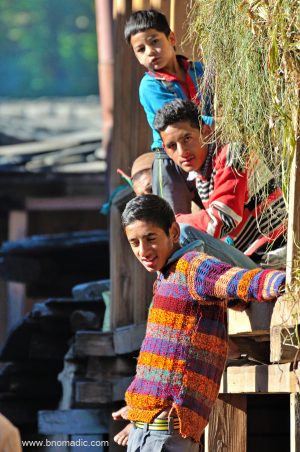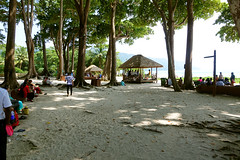It is already dark as I reach the village bus stand of Kwar (2419m). With no permanent shelter, the bus stand is actually a wider portion of the motorway just at the entrance to the main settlement of Kwar. I ask for directions to reach the PWD Rest House. A curious passer by tells me that the Rest House is located on the other side of the village. The only narrow street through the village that barely allows passage of a vehicle takes me to the Dodra – Kwar Sub Divisional secretariat where the Rest House is located. A portion of the Rest House is permanently allocated to the SDM as his residence. The SDM is on leave to celebrate the long weekend with his family. The caretaker has warned me not to indulge in any touristy clamour in the complex otherwise “SDM saab will cancel your booking”. “I am just a silent observer”, I assure him. Tired from the daylong drive and activities, I call it a day after munching on a simple meal of daal and boiled rice.

The southwest-faced settlement of Kwar gearing up for the day. More images from the region at Flickr

Terraced fields on the facing mountain face across the Rupin Valley. More images at Flickr

Straight out of a canvas! Please visit Flickr for more images of the region

My abode at Kwar, the only room at the PWD RH. The remaining two rooms are permanently occupied by the SDM as his residence. Please visit Flickr for more images of the region
The sun rises in a clear sky next morning and by half past six; the face of the mountain across the Rupin is fully illuminated with the cheerful rays. On the other side of the valley, the village of Dodra looks like a tiny scrape on the green mountain face hanging below the Chanshal Pass. On the opposite mountain face, the fields appear to be bits and pieces of square that are sometimes red but mostly green. From a distance, the old wooden houses look like microchips placed in a brightly coloured canvas set in the rolling expanse of rocks. The soon-to-be-harvested Amaranth crop adds the fairylike redness to the green scape. As I lower my gaze, cubes of houses become clearer, colours glinting among the plethora of grey, white and beige, speckled with grass and cloths. In between, a spire or pole sticks out of the terrain like a needle. Around me, the moss, ferns, grass and wild flowers are a delight; and shine boundlessly in the morning sun. The morning breeze whispers and chucks itself among unswaying firs, chinars, deodars and walnuts; and only frail branches move. The wind brings fragrance of burning wood and that passes me in an instant.

The Sub Divisional secretariat compound doubles up as a parking space as well as a playground. The Police Station is also a part of this complex. The Rest House is immediately behind the green roofed structures. Even though, a BSNL tower is installed withing this complex, the internet connectivity is very poor. BSNL is the only service provider in this valley. More images from the region at Flickr

Morning game of kabbaddi. The pro kabbaddi fever has caught up with the school kids. Even though, this valley has no history of playing kabbaddi but the youngsters have learned the rules through TV only and often try to imitate their favourite star players. More images from the region at Flickr

View towards the head of Rupin Valley from the village. Please visit Flickr for more images of the region

The valley is preparing to embrace the harsh winters which are just around the corner; grass and forage for their cattle is being stocked on a war footing. Please visit Flickr for more images of the region

The red in the landscape is the soon-to-be-harvested Amaranth (chollai) crop. More images at Flickr
By seven, Mangal, a young man who works with the SDM’s office turns up to meet me. Sent by the local patwari, whom I met at Dodra the previous evening, he has merrily agreed to take me through the settlement of Kwar. In his helpful company, walking with a backpack and a couple of camera bodies, I wouldn’t be considered an alien, I suppose. Walking up slowly through a settlement and enjoying my anonymity has always been a unique experience for me. Here, I am the only outsider in the valley. It is intensely cold as we begin and even a mild breeze makes us shiver. We hike up the narrow lanes of Kwar, greet every resident we come across and exchange notes, under the shadow of distant ranges in a cloudless sky.
The early morning cold lifts to reveal school-bound children, tight-faced in anticipation of a long day ahead. A few kids, boys mostly, are hesitatingly trudging ahead. Most shops on the street have old-style wooden door shutters that are closed at this early hour. The tea and vegetable shacks are just beginning to open for the day’s business. As warned by the caretaker of the rest house where I am staying, I place an order for lunch in advance. Rajma Rice he confirms! There aren’t many options to eat in the village so one has to really manage his meals by placing an order in advance. You’d be really unlucky if someone, mostly officials and employees on visit who come unannounced, drops in and ask for something to eat before you could get a chance. I was unlucky on two occasions when someone else polished off the limited food which I had ordered for myself. Before I realise, a few villagers are running towards the bus stand where the bus is about to leave for Rohru. The morning bus from Kwar will reach Rohru in the evening on the same day. The road has opened up many possibilities for the local people and likewise the valley is now more accessible to travellers like me. Fortunately, it has not yet taken a heavy toll on the dense forest cover, culture and peace.

An old man surrounded by youngsters soaking in the morning sun. More images at Flickr

A music shop-cum-agri medicine shop by the main street of Kwar. Farmers rue the fact that they do not get the best of insecticides and fertilisers at Kwar, therefore, they end up cultivating their fields organically

The main street of the village and a Kuthar, small wooden building meant to store grains and ration for the season.

An aged villager soaking in the morning sun outside his home by the street. More images at Flickr

A sheep is being sheared by the shearer. Please visit Flickr for more images of the region
The residents are already busy with morning chores; girls cleaning utensils, men tending sheep, boys carrying buckets full of water to store for the day, elderlies setting up the courtyards to dry their ration, nuts and fruits. Men and women from almost every house are off to their fields to get grass and forage for their cattle. Winters are just around the corner and they have to carry extra bulk on their backs to stock for the long season that is fast approaching. Everyone is curious to see a geared up visitor in their village. I do my best to maintain my anonymity. Even Mangal is very supportive. At every turn, he does his best to clear the air about my being and informs his village folks that I am just a travel writer who wishes to write a book on our village – Kwar. Almost everyone instantly acknowledges and agree to share notes. Girls are still shy. There is a hint of wood smoke in the air. With steam pouring out of spouts of kettles; the warm aroma of smoke and steam is mingling with the putrefied stench of rotting garbage and water in the drains. As the noon nears, house ladies, many of whom are now back from the fields, gathers at the community washing point to wash their cloths. This could be any village of the valley, Mangal acknowledges as we trudge ahead.

The lanes of Kwar; Mangal leads the way. Please visit Flickr for more images of the region

The Kwar Jakh temple; the devta of this temple is considered to be very powerful who loves animal sacrifices. The courtyard is also the place where the villagers gather for community activities.

Young kids are curious to see an alien in their village. Winter-fodder for cattle is being sun dried in the courtyard

The apple crop has been harvested elsewhere barring a few pockets which are mostly in the upper reaches. Due to less availability of insecticides, the crop is mostly organic. More images from the region at Flickr
Not much has been written about the history and cultural aspects of Dodra – Kwar valley. The antecedents of the people of Dodra – Kwar are not available in any written records. Being the inhabited part of the Rupin Valley, a traditionally popular artery that connects the Baspa Valley and the HT Road with the Tons Valley and Dun Vale, the Dodra – Kwar villages were always circuitously connected with the outer world for a substantial part of the year. Yet the beautifully mysterious Dodra – Kwar villages remain almost unheard of outside the Himalayas and little known by those who are part of it. Much of this isolation is down to simple geography. The road may have connected the valley with the main circuit but various primitive traditions, beliefs and superstitions continue to survive and flourish. Folklores are held in awe. Local sources are largely a blend of myth and folklore and the early origins have to be gleaned from the larger story of other Himalayan kingdoms and its surroundings tracts.

School kids! School starts in late morning and ends early evening. More images at Flickr
With a temple at every village, Hinduism prevails almost in totality. Even though a substantial population is educated and serve in the state administration, animal sacrifices are still a common occurrence. I am particularly interested in observing their temples along with devtantra, traditional costumes, house architecture, life, culture, and customs and not to forget the strange dhaada marriage ceremony. Mangal tells me that dhaada marriages, in which the groom’s family forcibly runs away with a bride of their choice, are no longer a commonplace. The last dhaada happened four years ago. Women, of course, enjoy a better social status in this valley than in most places in India. They can wilfully marry or divorce and remarry without any social disapproval and generally hold their heads higher than conventional Hindu society would allow elsewhere.

A recent shrine dedicated to Goddess Kali Mata. Please visit Flickr for more images of the region

A typical courtyard at the junction of lanes in Kwar; each family has its own Kuthar. More images at Flickr

A typical entrance door of a Kuthar; notice the wood carvings and the traditionally styled door lock

Community that washes together, stays together; the water is channelised in pipes from natural streams up the slopes

An old man spreading the grains on a sack-sheet to dry in the courtyard. More images at Flickr

Another courtyard where cow pats as well as grass is being sun-dried to stock for harsh winters ahead

An old lady guarding apple slices which are being sun-dried; the dry fruits work wonders during winters
Kwar, a village of three panchayats and a few hundred of houses is surrounded by a plenty of fruit orchards towering above a hospitable valley. Hiking up the narrow lanes of Kwar, we reach the courtyard of the Kwar Jakh devta temple. The houses in the valley are almost entirely built of wood, stone, slate and mud; and just as every house, the principal temple is also adorned with notable carvings on the wood. Mangal takes me to a few olden houses of the village. Now abandoned, these multi-storeyed houses belong to the early previous century. Typically five-storeyed, these imposing buildings owe their existence to the harshness of the terrain and the climate. As elsewhere in the valley, the houses are built using locally available materials like stone-filled solid platforms and there is an extensive use of wood. The height of these houses is anything from seven to ten metres above the base constructed on an elaborate, solid and raised platform. Mangal confirms that the sole purpose of these houses was safety and not much attention was paid to the comfort of the inhabitants. It is for reasons like these that people are increasingly abandoning such dwellings in recent times. The ground and the first floor are usually meant for livestock. Dry woods for winter fuel are kept on the top floor. The walls are made of stone without any mortar but the layers of stone are interspersed at regular intervals with wooden beams to provide bondage. The height of a storey is generally about a couple of metres and doorways are even lower. Small apertures, left in the walls, function as windows. Walls are mud plastered on the inside and sometimes have rudimentary drawings of birds, fruits and scenes reflecting everyday occurrences. Narrow verandas, running around three sides of the upper storey are a common feature. The main living room also functions as the kitchen. The thoughtful construction of such houses helps the residents to survive long harsh winters. With warmth trapped inside the structure, the residents don’t need to step outside during long spells of snowfall and can move freely between the floors.

Okay! So the rule of the game is: Book a meal not only in advance but make sure you are there to consume it on time. Otherwise दाने दाने पर लिखा है खाने वाले का नाम! More images at Flickr

The shutters of this tea shop also serves as the official notice board. More images at Flickr

Not even the residents but sheep are also curious to find an outsider in their village. More at Flickr

Time for some nutrition! Salt is essential for many body functions of sheep. More images at Flickr

An old couple resting after completing their morning chores. More images from the region at Flickr

Leaving elderlies to guard, the young residents have proceeded to their fields; notice the white-coloured headgear called khabeta, which has now been replaced by bushehri topis especially among the younger folks.
Leaving elderlies to guard, the young residents have left their seasonal agriculture produce to dry in the courtyard before proceeding to their fields. Mangal helps me with local names of the grains that I am not able to identify. I buy a local variety of rajma along with a few kg of chollai and koda at market rates. Agriculture produce comprising indigenous super foods forms the basis of their nutritious and traditional diet. Given the limited ability to grow, procure and process foods at such an enclosed harsh terrain, the frugal nature of the cuisine is but logical. I am happy to have procured some of the food grains I asked. Popular grains include wheat, buckwheat, barley, peas, mustard, bathu, chollai, mandwa, china, ogla, chavru, maize and some varieties of rice, etc. Fafra is one grain which is loved by Himalayan Bears that roam freely in the forests that surround the village. Otherwise, fafra is mostly used to distil liquor at home by the villagers. On festivals and special occasions, villagers consume copious amount of home distilled liquor for days together which is a socially accepted norm here.
Mangal tells me that food habits of the locals are changing drastically with the coming up of road. Nowadays, land is increasingly devoted to production of cash crops like apple, almond and green peas. The government supported public distribution system had brought essential commodities, like wheat, rice, sugar, vegetable oil and pulses to the remotest village in the valley at much reasonable prices. I am a trifle disappointed to hear him say this. The next few days are devoted to exploring the lanes of Kwar, Pujarli and Dodra.

The main concern of villagers is to stock for the long winters ahead. More images from the region at Flickr

And every household member chips in. Please visit Flickr for more images of the region

Curious onlookers! More at Flickr

Just as these kids, many in the village are keen on getting themselves photographed. More at Flickr

Kwari Belle in their traditional outfit; the bushehri topi has gradually replaced the traditional dhaathu to be a popular headgear. The black coat is called judki. Tying the colourful lakhoti around waist is part of the traditional outfit. The traditional silver jewelry is of course missing in this casual frame. Nowadays, women wear the traditional jewelry only during festivals or wedding ceremonies. More images from the region at Flickr
Getting There
The village of Kwar is 42 km from the Chanshal Pass, which is nearly 50 km from Rohru in district Shimla. Separated by the Rupin, Dodra and Kwar are 22km from each other.
Altitude: 2500 m
Best time to visit: Autumn
Travel Lure: Culture and sylvan charm
Accommodation: Very limited at Kwar
 bNomadic
bNomadic


















Pingback: The mysterious Dodra Kwar | bNomadic
Spellbound with the narration… Thanks for bringing stories from this unexplored secret region.
Thanks Shubham for stopping by the blog! Very glad to know you liked the post. Hope you’d be following the remaining posts of this series. Visit bNomadic more often 🙂
This place resembles Austria from a far distance 🙂 but as you scroll down the post, you begin to notice the enchanting Dev Bhoomi enveloped in a layer of simplicity and modesty 🙂 I have always loved Himachal, yet to explore this side though…
Thanks for stopping by the blog! Dodra-Kwar is a beautiful corner in the eastern Himachal Pradesh. You’d like visiting this place. Keep visiting bNomadic for more such travel stories 🙂
beautiful images and a nice write up. would appreciate opinion on my stories.
Thanks Shoma for stopping by the blog! Keep visiting bNomadic for more such travel stories 🙂
What a wonderful and unique write-up about a community we don’t hear much about!
Thanks Lalitha! Glad you liked the post. Kwar is indeed a beautiful village in the beautiful Rupin Valley. Keep visiting bNomadic for more such travel stories 😊
Fabulous as always. I so love the photographs. Glad you are writing so much about the locals. Kudos.
Thanks ji! Very Happy to notice you liked the photographs as well as the description. Keep visiting and showering your love on bNomadic 😊💐
Thank you for another excellent post with superb pictures, about a fascinating and resourceful people still holding onto their traditions. Lovely wooden buildings, colourful clothes and beautiful faces (not least that very old lady’s). Let’s hope that they will continue with organic farming and with what makes them unique…
Thanks for stopping by the blog! Very glad to notice that you liked the post. Dodra-Kwar is a beautiful region but I am of the view that soon the valley would be popular just as other pretty corners of the Himalayas. Keep visiting bNomadic 🙂
Hey , I belong to dodra kewar and would like to thank you for exploring our area and you have written so well about your trip,most of the people visit there and instead of getting inspired from the hardworking people of d.k ,some people make fun of them,they don’t even understand the circumstances of the area.So once again thanks that you visited and wrote so well,wish u good luck,keep it up.
Thanks Ranjana! The valley deserves to be on the national travel and cultural map. Hoping that the valley gets connected with Uttarakhand soon. The road connectivity will definitely improve the chances. Looking forward to remain in touch. 🤗